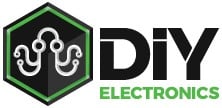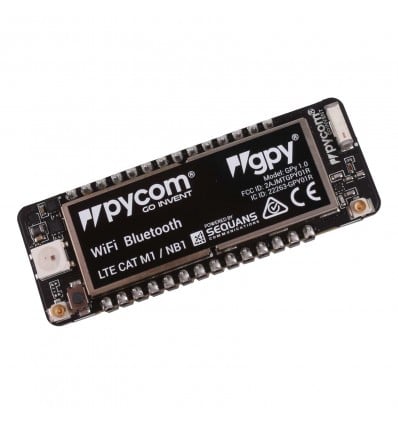International shipping Secure payment
No products
Prices are tax included
Product successfully added to your shopping cart
There are 0 items in your cart. There is 1 item in your cart.
Pycom GPy IoT Dev Board - BLE, WiFi & Dual-LTE
9PYCOMGPY
New
The Pycom GPy IoT Dev Board blends BLE, WiFi & Dual-LTE for the ultimate in all-range communications, with a powerful MCU and diverse functionality.
2 Items
Warning: Last items in stock!
Free shipping on orders over R1250 - courier delivery and within South Africa
When you have a project that extends far beyond just a home or office space, sometimes cables are not the ideal choice, as they can be reasonably expensive in high lengths, and are also prone to damage and interference in quite a wide range of different settings. Fortunately though, wireless communications have drastically dropped in overall price over the past couple of years, and it’s exciting to see that we, as Makers, are finally getting some very high quality IoT Development Boards and wireless modules to experiment with and use in awesome projects – at an actually affordable price that Makers like us can justify.
The Pycom GPy IoT Dev’ Board is a perfect example of how wireless comm’s are finally becoming truly affordable for Makers, as it features three different wireless protocols on one tiny board, operating on minimal power but offering impressive levels of processing power and functionality. The GPy is certainly a unique board compared to many Development Boards on the market, and is part of the Pycom LPWAN IoT Boards range that focuses purely on Low Power Wide Area Networks. It offers the classic Bluetooth and WiFi functionality that is ever-common in our modern world, and enhances this further with Dual LTE Cat-M1 and NB-IoT. These three protocols make the board amazing for short, moderate and long-range communications, catering to an incredible number of applications and opening up fresh new opportunities for advanced prototyping and product design.
Three Communications Protocols on One Tiny Board!
With the three similar but distinct protocols featured on the Pycom GPy IoT Dev’ Board, we imagine that it would be perfectly suited to both large and small-scale projects, being capable of tracking fleets of vehicles across a country (and more precise tracking within a loading bay or warehouse) while simultaneously being excellent at providing interoperable Communications between various devices and systems within smaller zones.
So let’s quickly take a closer look at these three featured protocols on the Pycom GPy, and what kinds of functionality each one offers to Makers:
- Bluetooth – Being one of the communications that were popularised in early days, back when Nokia were still producing their glorious brick phones, there are very few people who don’t know what Bluetooth is, with a lot of people commonly using it on a daily basis. However, this Bluetooth is designed around the Bluetooth 4.2 standard, and features both BLE (Bluetooth Low Energy) as well as BR/EDR for streaming and audio applications too. And while it may not be the most powerful or versatile protocols around, the low cost and simple nature of it has allowed it to become integrated into almost all wireless devices nowadays. This makes it a great addition to any module or board, regardless of what else it might also offer, and adds a good range of functionality that is an excellent solution for a reasonably wide number of use cases.
- WiFi – With the rise of the internet and the ways in which we interact with it, with routers around the home and WiFi included in almost every phone since 2018, WiFi is definitely a close competitor to Bluetooth in terms of widespread use and functionality. And while it doesn’t quiet feature the extremely low cost that Bluetooth offers, it certainly has some impressive benefits that make it the best choice for high data rates at moderate distances. This, when coupled with Bluetooth, is already enough to make IoT Development Boards incredibly versatile, and with an impressive range of 1km (we recommend an External 2.4GHz Antenna for this) you can create complex mesh networks and nodes even over large areas like farms or massive warehouses.
- Dual-LTE – Finally, the addition of Dual LTE Cat-M1 and LTE NB IoT means that this development board is not only brilliant at low power long range communications, but also moderate data throughput at close ranges too. And while it doesn’t quite have the full functionality that we see nowadays in LTE routers and modern mobile devices, it is more than capable of handling almost any data transmissions that need to be made for small to large projects. Furthermore, the Dual-LTE on this board also means that it is truly a global board, being able to connect anywhere in the world.
While each of the protocols featured on this board are certainly impressive each in their way, when working together, they can really take projects to the next level, and allow Makers like you to create true masterpieces in terms of interoperability and (very) wide area networking. And of course, these are all just extra features to complement the onboard Xtensa Dual-Core 32-bit LX6 MCU, while the Micropython capabilities mean that it’s almost as easy as operating a Raspberry Pi or similar kind of development board.
Please Note: It is EXTREMELY IMPORTANT that you make sure to connect the Pycom LTE Antenna when using the LTE functionality, as doing so without the antenna WILL cause damage to the board and the antenna port.
Pycom GPy IoT Dev Board - Technical Specifications: |
|
|
– Pycom |
|
– 3.3V DC |
|
– 3.5V to 5.5V DC |
|
– 3.3V DC @ ≤400mA |
|
– 60 to 192mA |
|
– Xtensa® Dual-Core 32-bit LX6 @ up to 600 DMIPS |
|
– 150 kHz |
|
– 512kB Internal – 4MB External QSPI RAM |
|
– 8MB |
|
– 802.11 b/g/n/e/i |
|
– 2.4 GHz |
|
– 1km |
|
– Bluetooth V4.2 – Bluetooth BLE – Bluetooth BR/EDR |
|
– LTE Cat-M1 – LTE NB-IoT – LTE-A Pro |
|
– Cat-M1 Up: 375 kbps – Cat-M1 Down: 300 kbps – NB-IoT Up: 55 kbps – NB-IoT Down: 40 kbps |
|
– TX: 699 to 915 MHz – RX: 729 to 960 MHz |
|
– TX: 1710 to 1980 MHz – RX: 1805 to 2170 MHz |
|
– Low: 5, 8, 12, 13, 18, 19, 20, 28 – Mid: 1, 2, 3, 4 |
|
– SSL/TLS Support – WPA Enterprise Security |
|
– SHA / MD5 / DES / AES |
|
– CE RED | RCM | ROHS | IC | CE |
|
– 30g |
|
– 7g |
|
– 55 x 20 x 10mm |
Typical Applications for the Pycom GPy IoT Dev Board:
After experimenting with the Pycom GPy IoT Dev Board for a while, we’re quite confident in saying that it is truly one of the most versatile IoT Boards that we’ve had the chance to play around with, second of course to the Pycom FiPy IoT Dev’ Board, which features BLE, WiFi & Dual-LTE, as well as Sigfox and LoRa. We imagine that this board is excellent for, for example, tracking and communicating between a fleet of vehicles across the country. The LTE capabilities mean that any of the devices can communicate at almost any range via cellular networks, while the WiFi and Bluetooth allow for communications within smaller zones so as to cut out the cost of LTE when it’s not necessary. Of course, you as a brilliant Maker may certainly have even better ideas on how to use this board, and we wouldn’t be too surprised either, as the wide functionality and capabilities of this board truly do lend themselves well to almost any application from small sensor networks to large-scale tracking and monitoring.
Additional Resources:
- One of the best things about Pycom is that they are very community-focused, and have a handy Pycom Documentation Hub, where you can find datasheets, pinout diagrams, tutorials, guides, firmware and other handy resources.
- Finally, if you’re still stuck or looking for answers after reviewing the datasheet and other resources, the Pycom Official Forum is the place to go, where you can ask questions, share ideas and get help with troubleshooting.
Finally, if you’re looking for a more hands-on approach to learning about this board, the following video by Core Electronics will briefly take you through the basics, some getting started tips, as well as some troubleshooting for if you run into problems during setup:
No customer reviews for the moment.





